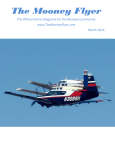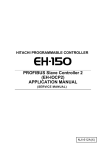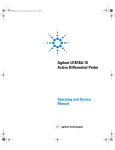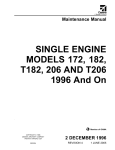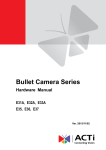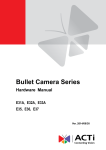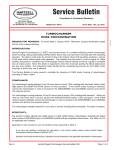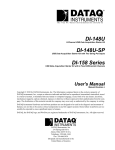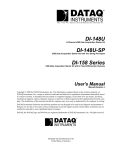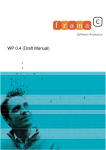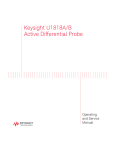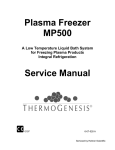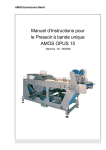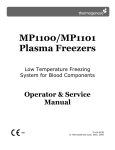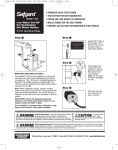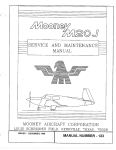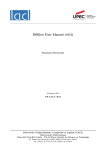Download Left or Right Side Windows Report No. 978/CON
Transcript
1086 Bouquet Road Jeannette, PA 15644 (800)957-2376 Left or Right Side Windows Report No. 978/CON Installation Drawing List Applicable Aircraft Models Beechcraft 35-33 thru G33 35-C33A thru F33A E33C thru F33C 35 thru V35B 36 thru A36 A36TC thru B36TC B50 thru C50 D50 thru D50E E50 thru J50 95-55 thru 95-B55A 95 thru E95 95-C55 thru E55A 56TC thru A56TC 58 and 58A 58TC and 58TCA s/n CD-1 thru CD-1304 s/n CE-1 and up s/n CJ-1 and up s/n D-1 and up s/n E-1 and up s/n EA-1 and up s/n CH-12 thru CH-360 s/n DH-1 thru DH-347 s/n EH-1 thru JH-176 s/n TC-1 and up s/n TD-2 thru TD-721 s/n TE-1 and up s/n TG-2 thru TG-94 s/n TH-1 and up s/n TK-1 and up Page Numbers 1 through 10, inclusive - 1/28/97 Report No. 978/CON 1/28/97 Page 2 Revision Control Page Revision Date Pages Affected Remarks Report No. 978/CON 1/28/97 Page 3 OPTION 1 INSTALLATION & REMOVAL INSTRUCTIONS FOR LEFT AND RIGHT FRAMED SIDE WINDOWS USING THE ORIGINAL BEECHCRAFT WINDOW FRAME 1. These windows are trimmed to fit inside the original window mounting frames which are then fastened to the airframe. Read and thoroughly understand all of the following instructions before proceeding with the installation. 2. Follow the Beechcraft service manual for removal of the window and frame from the airframe. After removing the interior window trim, mark the location and mounting direction of all trim attachment tabs. These tabs must be replaced exactly as removed for proper trim screw mounting tab positioning during installation of the interior trim. Numbering the tabs is recommended. Remove all old sealant from the inside of the skin. 3. Drill through the center of each spot weld using a #40 drill bit. Mark each of these holes so that they can be flush riveted back together on the new window and will not be confused with the frame mounting rivet holes. After drilling, the welds may be broken with a thin, sharpened putty knife struck sharply with a mallet. See figure 1. Exercise care not to distort the frame. Countersink the outside of the holes that were drilled through the spot welds. 4. Once the inner and outer sections are separated, remove all old sealer with MEK or other solvent. Some sealants are polysulfide based (Pro Seal, PRC, Chemseal, etc.) and can best be removed using a polysulfide sealant remover, such as Eldorado SR-125A manufactured by Eldorado Chemical Co., San Antonio, TX (1-800-531-1088). 5. Fit the frame to the new window, trimming the window and inner edge of the frame as necessary. The window is trimmed and the edge of the inside surface is milled to fit the frame at our factory, however a sander or file may be used to remove any excess acrylic. The inner aluminum frame inside edge varies in size and may need to be trimmed, if when fitted to the window the frame hits a portion of the acrylic which has not been milled. Smooth the inside edges of the frame after trimming to prevent the frame from biting into the window radius cuts. 6. Cleco the inner and outer frames together. These holes must be carefully countersunk, 100 degrees, on the outside frame. With the frame in final position, apply masking tape to the window just to the edge of the frame and also apply masking tape to the frame. This will protect both from the excess sealant. If a double layer of masking tape is used, the sealant may be smoothed with your fingers or a spatula while still wet, and the outer layer of tape can be removed leaving a clean layer to protect your surfaces during curing. 7. Place sealant (Chemseal CS3204-B2, GE RTV 108, Dow Corning RTV 732, Bostik 1100 FS or equivalent) in the channel of the frame. The new window should now be fitted into the frame, allowing the excess sealant to be squeezed onto the tape. Rivet the two halves together using MS20426-A4 rivets or equivalent. A layer of masking tape can be placed over the joints while fitting to prevent any oozing sealant from getting on your fingers and contaminating other surfaces. This layer may then be removed to allow you to smooth the sealant around all edges leaving a good fillet. Remove the top layer of masking tape with excess sealant. Report No. 978/CON 1/28/97 Page 4 8. Fit the window into the aircraft and cleco it into place, allowing the sealant to cure. Remove the masking tape and excess sealant. 9. After curing, remove the window. Mask the airframe as you did the window. Apply sealant as recommended by the Beechcraft service manual. The window and frame assembly may now be reinstalled on the airframe and the installation completed using the Beechcraft recommended installation instructions in the Beechcraft service manual. Remove all the masking. OPTION 2 INSTALLATION & REMOVAL INSTRUCTIONS FOR LEFT AND RIGHT FRONT SIDE WINDOWS ELIMINATING THE ORIGINAL BEECHCRAFT WINDOW FRAME 1. These windows are trimmed larger than the original windows to allow them to be fastened directly to the airframe, thus eliminating the aluminum mounting frame. Read and thoroughly understand all of the following instructions before proceeding with the installation. 2. Follow the Beechcraft service manual for removal of the window and frame from the airframe. After removing the interior window trim, mark the location and mounting direction of all trim attachment tabs. These tabs must be replaced exactly as removed for proper trim screw mounting tab positioning during installation of the interior trim. Numbering the tabs is recommended. Remove all old sealant from the inside of the skin. 3. Place the new window against the upper hat section and push the window bottom past the lower hat section until it pops into position. The window has been trimmed closely to fit the airframe, but it may require a final trim to fit. If required this can best be done by using a belt sander, body grinder, or band saw. Both the belt sander and body grinder will remove the material slowly and help prevent over trimming. Peel the protective covering from the window edge just enough to expose the working area and, with the window in position, check that the window fits flush against the outer skin. If it is resting on the radius of the hat section, fitting needs to be done to allow the window to clear the hat sections. Mark the areas to be trimmed or radiused with a grease pencil. Remove the window by pushing against the bottom of the window and trim with a disc or belt sander, hand sanding block, or file. Again, trim only enough that the window fits flush with the skin. The object is to preserve enough window edge material to provide adequate minimum edge distances for the fastener holes. Be sure to break all edges, remove all saw marks, and sand smooth using 150 grit or finer sand paper. 4. With the window in position and starting at center of the sides and working alternately up and down and around, drill holes in the window through the existing holes in the skin using a 1/8" AACRYLIC@ bit. REMEMBER THAT YOU ONLY GET ONE CHANCE TO DRILL A HOLE WITHOUT CRACKING THE WINDOW - USE THE CORRECT DRILL BIT!!. These drill bits scrape a hole through the acrylic similar to a wood spade bit, they do not cut. As each hole is drilled, insert an appropriately sized cleco fastener to maintain the window position. Drill carefully using a high speed and extrmely light pressure, let the drill bit do the work. The object is to drill smooth, clean holes with no edge chips. Excess drill pressure may crack or chip the window as the bit breaks through the bottom side of the hole. You may want to practice drilling the old window. Report No. 978/CON 1/28/97 Page 5 5. After all holes are drilled and the window is held securely in position with the cleco fasteners, cover the edge of the window where the window meets the fuselage skin using 3/4" or wider masking tape. Allow a slight gap between the masking tape and the skin to create a fillet with the sealant. Also apply masking tape to the aircraft skin. Apply masking paper to cover all exposed window surfaces and tape those edges. This will protect the entire window surface from excess sealant as the window is installed. If a double layer of masking tape is used, the sealant may be smoothed with your fingers, a spatula, or a pencil eraser while still wet. The outer layer of tape can be removed leaving a clean layer to protect your surfaces during curing. 6. Remove the window and drill out all holes with a 1/4" AACRYLIC@ bit. Chamfer both sides of all holes using a countersink or conical mounted stone. Do not allow the countersink to chatter. If any rough edges are produced by a chattering countersink, they must be smoothed, preferably with a fine stone. The object is to remove all sharp or irregular edges. 7. Each hole must have a minimum edge distance of 1/4". If any hole has less than the required 1/4", the hole may be notched and a backing support may be used. This may be in the form of a backup aluminum angle cut to length, or large washers (AN970-6 or equivalent), or a combination of large washers (AN970-6 or equivalent) and 1/4" aluminum tube cut to the same length as the thickness of the acrylic and used as a spacer. Trim any oversized washers to clear any interior trim panels. See Figure 2. 8. All mounting holes in the aircraft skin must be dimpled to accept the flush mounting screws (MS24693C or equivalent). You may use a truss head screw (AN526C-632 or equivalent) to eliminate the need to dimple the skin. Prime each hole with zinc chromate primer if the paint has been removed. 9. Carefully place the window in position, insert screws and just start the tinnerman nuts on the screws. While doing this, replace the trim retaining tabs in their original positions. Do not tighten the screws yet. 10. DO NOT USE ANY SEALANT OTHER THAN THOSE RECOMMENDED OR THEIR EQUIVALENTS! THE SEALANTS MUST MEET MILITARY SPECIFICATION MIL-S-8802E TYPE II, CLASS B. The following is a partial list of approved sealants: Manufacturer Sealant Chemseal Corp. (Sealpak Company, Inc.) CS 3204 B-1/2 or -2 Goal Chemical and Sealants Corp. GC-408B-1/2 or -2 or -4 Products Research & Chemical Corp. (PRC) P/S 890 B-1/2 or -2 or -4 (Courtlands Aerospace) PR-1440 B-1/2 or -1 or -2 or -4 Thiokol MC-236 B-1/2 or -2 The dash number on these sealants is the working time. We recommend that the 2 hour work time be used. This will give you sufficient time to make any adjustments and smooth out the fillets at the joints. The sealant is a two part system which requires a thorough mix prior to use. It is available in both small cans, which need applied by using a 1" putty knife or in cartridges which require a special hand application gun, similar to a caulking gun. The cartridges contain both components along with a plunger for ease of mixing and application. This is a much cleaner and faster application method. Remember to protect all surfaces from these sealants by covering and masking. The solvents needed for clean up will probably attack the surfaces you need to clean. Complete all masking. Report No. 978/CON 1/28/97 Page 6 11. Using a putty knife or small spatula, apply mixed sealant between the window and the outer skin and hat section of the aircraft. Be sure that all screw holes are completely filled with sealant, as cured sealer acts as a cushion as the window expands and contracts. Make sure there are no voids in the sealer that could cause water leaks. 12. Tighten the screws just enough to pull the window into final position and the sealer is uniformly spread between the window and the outer skin flange. Do not over-tighten. When cured, the sealant will act as an adhesive to hold the window in position. 13. Before the sealer begins to cure, attach the interior trim to the mounting tabs so the tabs and screws can still be moved as necessary. Start at the bottom of the window and work toward the top, leaving all screws loose until all have be started, then gently snug into place, being careful not to over-tighten. 14. Smooth the sealant in each joint and peel the top layer of masking tape. A pencil eraser will work well to smooth a fillet along each joint. Once dried, the last layer of masking tape may be removed. Cut each mounting screw close to the tinnerman nut to avoid any interference with the interior trim panels. Reinstall the interior trim panels, glare shield and any other items which may have been removed during the installation. 15. After the sealer has firmed but before it is fully cured, remove the masking tape from the window and fuselage, and wipe off any sealant that may be left on the window or fuselage with isopropyl alcohol and a soft cotton cloth. Do not use any other solvent, as it will damage the window. Allow the sealant to fully cure prior to your initial flight. STEP BACK AND ADMIRE YOUR WORK. INSTALLATION OF REAR WINDOWS 1. Follow the Beechcraft service manual for removal of the window from the airframe. 2. The windows are trimmed to fit the original opening. Verify the fit in your fuselage for each window. Trim and fit as necessary. 3. Apply sealant as recommended by the Beechcraft service manual or you may use adhesive backed, 1 1/4" x 1/16" closed cell, foam sealing tape or Bostik 1100FS Urethane sealant or their equivalents. Insert the window into the frame and install the retainer moldings. These retainers may or may not need repositioned slightly to accommodate the thicker window. If drilling new holes, position them no closer than 4 diameters from the existing holes. 4. Reinstall all interior trim pieces. 5. Follow the guidelines on acceptable maintenance procedures in the FAA Advisory Circular AC 43.13-1A, or latest revision, in completing all phases of the installation. Complete 337 form. The weight of the original windows in .125" thickness are one half of the weight shown for the .250" thick windows. Account for the additional weight for operational performance in the weight and balance calculations. Report No. 978/CON 1/28/97 Page 7 WINDOW APPLICATION CHART Part No. WT Window Location All windows on left are applicable to Beechcraft models listed on right. 252.250 86 oz Left front pilot window 258.250 14 oz Vent window - use with p/n 252.250 978WV 978.375WV 134 oz 197 oz Left front frameless pilot window assembly with vent installed 187 16 oz Vent window - use with p/n 978, 978WV 187.500 24 oz Vent window - use with p/n 978.375 978.375WV 978 978.375 119 oz 177 oz Left front frameless pilot window Part No. WT Window Location 35-33 thru E33 35-C33A thru E33A E33C 35 thru V35A 36 95-55 thru 95-B55A 95-C55 thru D55A 56TC 95 thru E95 B50 thru C50 D50 thru D50E E50 thru J50 s/n CD-1 thru CD-1234 s/n CE-1 thru CE-289 s/n CJ-1 thru CJ-25 s/n D-1 thru D-9068 s/n E-1 thru E-184 s/n TC-1 thru TC-1298 s/n TE-1 thru TE-767 s/n TG-2 thru TG-83 s/n TD-1 thru TD-721 s/n CH-12 thru CH-360 s/n DH-1 thru DH-347 s/n EH-1 thru JH-176 F33 thru G33 F33A F33C V35B thru V35B-TC A36 A36TC thru B36TC 95-B55 and 95-B55A E55 and E55A A56TC 58 and 58A 58TC and 58TCA s/n CD-1235 thru CD-1304 s/n CE-290 and up s/n CJ-26 and up s/n D-9069 and up s/n E-185 and up s/n EA-1 and up s/n TC-1299 and up s/n TE-768 and up s/n TG-84 thru TG-94 s/n TH-1 and up s/n TK-1 and up 35-33 thru G33 35-C33A thru F33A E33C 35 thru V35B-TC 36 and A36 95-55 thru 95-B55A 95-C55 thru E55A 56TC thru A56TC 58 and 58A 58TC and 58TCA 95 thru E95 B50 thru C50 D50 thru D50E E50 thru J50 s/n CD-1 thru CD-1304 s/n CE-1 thru CE-632 s/n CJ-1 thru CJ-25 s/n D-1 thru D-9855, except D-9819 s/n E-1 thru E-830 except E-754 s/n TC-1 thru TC-1935 s/n TE-1 thru TE-1069 s/n TG-2 thru TG-94 s/n TH-1 thru TH-732 s/n TK-1 thru TK-4 s/n TD-1 thru TD-721 s/n CH-12 thru CH-360 s/n DH-1 thru DH-347 s/n EH-1 thru JH-176 All windows on left are applicable to Beechcraft models listed on right. 211 211.375 90 oz 135 oz Left front pilot window 188 188.500 16 oz 24 oz Vent window - use with p/n 211 Vent window - use with p/n 211.375 211WV 211.375WV 104 oz 156 oz Left front pilot window assembly with vent installed 978WV 978.375WV 131 oz 197 oz Left front frameless pilot window assembly with vent installed 187 187.500 16 oz 24 oz Vent window - use with p/n 978, 978WV Vent window - use with p/n 978.375 978.375WV 978 978.375 146 oz 168 oz Left front frameless pilot window Part No. WT Window Location All windows on left are applicable to Beechcraft models listed on right. 253.250 253.375 90 oz 134 oz Right front door window 230.250WV 230.375WV 104 oz 156 oz Right front door window assembly with vent installed 230.250 230.375 86 oz 128 oz Right front door window with vent opening 980 980.375 111 oz 167 oz Right front frameless door window 979WV 979.375WV 113 oz 170 oz Right front frameless door window assembly with vent installed 189 16 oz Vent window - use with p/n 979, 230.250, 230.250WV, 979WV 189.500 24 oz Vent window - use with p/n 979.375 230.375, 230.375WV, 979.375WV 979 145 oz Right front frameless door window 979.375 160 oz Note: All window weights are average. Report No. 978/CON 1/28/97 Page 8 WINDOW APPLICATION CHART Part No. WT Window Location All windows on left are applicable to Beechcraft models listed on right. 294.250 294.375 92 oz 137 oz Right front door window F33A V35B-TC A36 A36TC thru B36TC 95-B55 and 95-B55A 55 and E55A 58 and 58A 58TC and 58TCA 287.250WV 287.375WV 104 oz 150 oz Right front door window assembly with vent installed 287.250 287.375 90 oz 133 oz Right front door window with vent window opening 991 991.375 997WV 997.375WV 110 oz 165 oz 143 oz 158 oz Right front frameless door window Right front frameless door window assembly with vent installed 189 189.500 16 oz 24 oz Vent window - use with p/n 979, 287.250, 287.250WV, 997, 997Wv Vent window - use with p/n 979.375, 287.375, 287.375WV, 997.375, 997.375WV 997 997.375 92 oz 135 oz Right front frameless door window with vent opening s/n CE-633 and up s/n D-9819, D-9856 and up s/n E-754, E-831 and up s/n EA-1 and up s/n TC-1936 and up s/n TE-1070 and up s/n TH-733 and up s/n TK-5 and up Part No. WT Window Location All windows on left are applicable to Beechcraft models listed on right. 254.250 255.250 77 oz 77 oz Left #2 emergency exit window Right #2 emergency exit window E33 thru G33 E33A thru F33A F33C 35 thru V35B-TC 36 thru A36 A36TC thru B36TC 95-55 thru 95-B55A 95-C55 thru E55A 56TC and A56TC 95 thru E95 B50 thru C50 D50 thru D50E E50 thru J50 s/n CD-1119 thru CD-1304 s/n CE-180 and up s/n CJ-26 and up s/n D-1 and up s/n E-1 and up s/n EA-1 and up s/n TC-1 and up s/n TE-1 and up s/n TG-2 thru TG-94 s/n TD-1 thru TD-721 s/n CH-12 thru CH-360 s/n DH-1 thru DH-347 s/n EH-1 thru JH-176 35-33 thru G33 35-C33A thru F33A E33C thru F33C 95 thru E95 s/n CD-1 thru CD-1304 s/n CE-1 thru CE-315 s/n CJ-1 thru CJ-51 s/n TD-1 thru TD-721 35-C33 thru G33 35-C33A thru F33A N35 thru V35B-TC 95-55 thru 95-B55A 95-C55 thru E55A 56TC and A56TC B95A thru E95 s/n CD-814 thru CD-1304 s/n CE-1 and up s/n D-6562 and up s/n TC-1 and up s/n TE-1 and up s/n TG-2 thru TG-94 s/n TD-453 thru TD-721 36 thru A36 A36TC thru B36TC 58 and 58A 58TC and 58TCA s/n E-1 and up s/n EA-1 and up s/n TH-1 and up s/n TK-1 and up Part No. WT Window Location All windows on left are applicable to Beechcraft models listed on right. 140.250 141.250 82 oz 82 oz Right #4 window Right #4 window Part No. WT Window Location All windows on left are applicable to Beechcraft models listed on right. 284.250 285.250 83 oz 83 oz Left rear window Right rear window Part No. WT Window Location All windows on left are applicable to Beechcraft models listed on right. 024.250 025.250 028.250 029.250 28 oz 42 oz 24 oz 43 oz Utility door window – forward Cargo door window – aft Left #3 window Right #4 window Note: All window weights are average.











